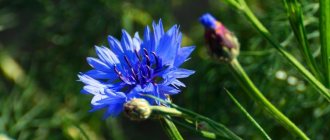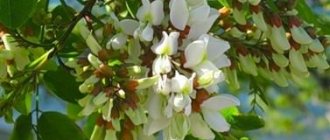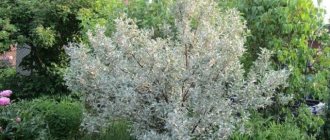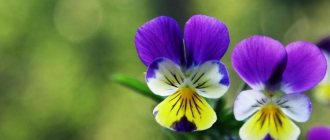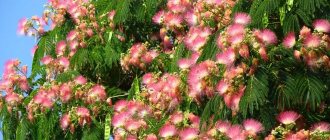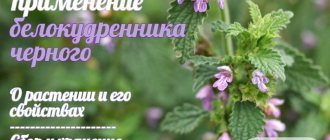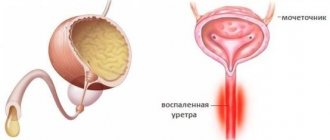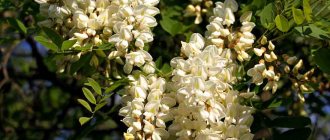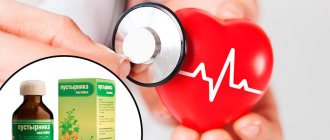Plant composition
Cornflower is a series of herbs from the Compositae family , which are distributed throughout Ukraine, Russia and other countries of Eastern and Central Europe, except for the northernmost and southernmost regions. Cornflower has accompanied people since ancient times and has always been considered a weed. This flower grows in fields along with cereals, along roadsides, in open meadows, and blooms from early summer until late autumn. In nature, there are cornflowers of bright blue, red, white, purple, burgundy, and yellow. There are 500 species of this plant in total.
The blue cornflower is considered the national flower of Estonia and is especially revered in Germany.
This flower is familiar to everyone thanks to its amazing blue color of the petals. The erect stem grows up to 80 cm in height. It is covered along its entire length with gray-green woolly leaves. Each flower is located on a separate stem in a single basket. The petals in the inflorescence are arranged in such a way that they resemble a royal crown. Thanks to this quality, cornflower is called a royal flower. Other names are voloshka (Ukrainian), blue flower, patchwork, blade.
Only the marginal blue petals of cornflower are used in medicine. This color of the petals is due to the presence of anthocyanin compounds - cyanines, cytaurines and cyanidins (derivatives of hydrocyanic acid). In addition, the medicinal flowers of the plant contain:
- flavonoids;
- glycosides with natural bitter components;
- carotene;
- ascorbic acid;
- coumarin;
- pelargonin chloride;
- acids: caffeic, quinic;
- tanning and resinous components;
- trace elements: zinc, cobalt, selenium, calcium.
Medicinal cornflower flowers are often combined with other medicinal herbs; it is included in many medicinal pharmaceutical preparations.
Cornflower flower (petals)
Where do they grow?
The wildflower Cornflower is often found on the European part of the continent. Also, the plant is found to a lesser extent in Central Asia, Western Siberia, Crimea and the Caucasus. It does not like the cold, so it does not grow in the Far North.
It has many other alternative names, such as Bear's heads, Blue cornflower, Blue, Bitter grass, Heart grass, Meadow blue, Voloshka, Rannik, Rust color, Tripusha, Rannik, Patchwork.
Scientific name in Latin: Centaurea Cyanus L.
The meadow plant Cornflower itself has a branched straight stem, no more than 60 cm in height. Its flowers are blue (blue) in color and reach approximately 3 cm in diameter.
Cornflower flowers - medicinal and beneficial properties
For a long time, cornflower blue has been known as a medicinal plant. It is used in folk medicine as an antispasmodic, antipyretic, anti-inflammatory, diuretic, diaphoretic and antiseptic.
Flower extracts are used in medicinal preparations, for example, as eye drops for eye diseases such as blepharitis, conjunctivitis, night blindness….
Used as lotions for eye diseases and blindness.
When taken orally, the healing properties of the plant help in solving problems of the cardiovascular system, gastrointestinal tract, and other internal organs, such as the gallbladder, kidneys (pyelonephritis, cystitis, nephritis).
Flowers have a rich composition of useful microelements and vitamins, glycosides, tannins, flavonoids, mineral salts, alkaloids, coloring matter, in particular, saponins and vitamin C. As is known, these components help strengthen the human immune system, relieve spasms, and reduce fever. As a natural remedy, it is used for such conditions and diseases as sore throat, colds, cough, fever, headache, worms, gout, jaundice, colic.
Due to its wound-healing and antiseptic properties, the plant is often used as an external remedy for the treatment and speedy recovery of furunculosis, eczema, and ulcers.
Blue cornflower flowers - application
Most often, plant raw materials are used for therapeutic and prophylactic purposes in the form of infusions, decoctions, eye drops, and compresses. Below are some recipes for preparing healing potions.
Cornflower decoction
One tablespoon of flowers should be poured with 1 glass of hot water. Leave in a water bath for 30 minutes. Let cool for 1 hour. Add warm boiled water to the broth to obtain the original volume of liquid. Drink one tbsp orally three times a day. spoon.
Compress
Cornflower blue compresses are used to treat varicose veins and tired legs.
To prepare it you need 30 g of plant material and 0.5 liters of boiling water. After the natural raw materials have been poured with hot water, the solution should infuse for 1 hour. It is applied to problem areas of the legs, and depending on how you feel, it lasts for 20-40 minutes.
Cornflower infusion
This recipe is for internal use. To prepare it, you need 250 ml of hot water and 1 teaspoon of flowers, which are poured and infused for 60 minutes. Then the tincture needs to be filtered. Take 100-150 ml 3 times a day before meals.
Eye drops with Cornflower
The drops include not only this herb, but also plants such as rose hips, chamomile, plantain, and elderberry.
To prepare the drops, you need two parts of Cornflower flowers, one part of Great Plantain leaves, one part each of Elderberry, Chamomile, and Rosehip flowers. The resulting herbal mixture needs to be mixed, set aside 3 tablespoons, and then pour 200 ml of boiling water over them.
After the solution has cooled, it is recommended to strain it thoroughly using cotton wool or gauze. Place 3 drops into eyes once a day.
Infusion for the eyes
One glass of boiling water needs to be poured into 3 tbsp. spoons of flowers. Let it brew for 2 hours. Moisten a cotton pad or gauze with the resulting infusion, which is subsequently applied to the eyelids.
Infusion for external use
The infusion according to this recipe is used externally for lotions and rinses. To prepare it you need 1 cup of boiling water and 1 tablespoon of dried Blue flowers. After the plant material has been poured, the infusion should sit for 1 hour. Before using the product, it is advisable to strain it.
Herbal recipe
To prepare it, you need to take 15 grams of yarrow herbs, horsetail, valerian root, chokeberry berries, hawthorn fruits, white mistletoe leaves, cornflower blue. Mix the whole collection. Pour 1 tablespoon of the mixture with 200 ml of boiling water and let it brew for 30 minutes. Afterwards it needs to be filtered. This medication is taken by people with high blood pressure (hypertension). Drink 80 ml after meals.
Cornflower flowers - contraindications
It is not recommended to use for a long period of time. It is not advisable for pregnant and lactating women to consume Cornflower flowers. Also contraindicated in the use of the plant are uterine and other internal bleeding.
Where can I buy cornflower flowers?
You can buy the color Cornflower blue (petals) in our online store “Buy-Travu.Ru” in Moscow and Russia, which is focused on selling herbs, medicinal plants, and health products at the lowest possible prices for its customers. Our online store www.kupit-travu.ru is an excellent solution to answer the questions - Where to buy cornflowers flowers inexpensively and quickly?
Compiling medicinal infusions from various medicinal herbs and plants on your own without certain knowledge is undesirable, since some herbs in the infusions are not always compatible with each other, which can cause an unfavorable effect with their further use in therapeutic courses. To create the most beneficial herbal infusions, it is recommended to contact herbalists!
Often asked about this unique plant - fireweed, hawthorn, mistletoe, tricolor violet, horsetail, valerian root, yarrow, chamomile, chokeberry, poppies.
Useful properties of blue cornflower
Anthocyanins in blue cornflower are natural dyes, the purpose of which is to make the flower or plant as bright as possible and attract bees or other insects for pollination. In terms of their therapeutic effect, they are powerful antioxidants. Thanks to antioxidants, the body's immune system successfully fights bacterial infections and inflammation. Anthocyanins are not produced by the body, so their reserves must be replenished from the outside. To do this, their intake together with food or herbal decoctions must be constant and continuous.
The bright blue color of cornflower petals is due to the presence of magnesium and potassium in anthocyanin compounds. These minerals are simply indispensable for stable heart function. The anthocyanin compound centaurine can slow down the onset of orgasm in men and help anyone who suffers from rapid ejaculation. So, thanks to cytaurine, your partner will become a tireless lover.
Bitter glycosides in the plant are complex compounds of plant origin, the therapeutic effect of which is aimed at stabilizing the work of the heart muscle and irritating the intestines. In addition, glycosides have an antimicrobial and mild laxative effect.
It is the presence of acids and flavonoids that determines most of the pharmacological properties of cornflower. Flowers have the following effects:
- choleretic;
- diuretic;
- antispasmodic;
- antipyretic;
- bactericidal;
- sweatshop;
- painkillers.
A large amount of anthocyanin compounds and other beneficial components are found in grapes of all varieties.
Use in folk medicine
In pharmacies, medicinal cornflower is sold in the form of essential oil of inflorescences, dry collection, and alcohol tincture. Ancient manuscripts mention methods of treating skin diseases with crushed flower seeds. But today these recipes are not used.
The medicinal collection of blue cornflower treats:
- hepatitis;
- cholecystitis;
- arrhythmia;
- high blood pressure;
- nephritis;
- cystitis.
Taking the medicinal tincture internally helps:
- lower the temperature during fevers or colds;
- get rid of swelling;
- improve appetite and digestion;
- relieve spasms from the bronchi during severe coughing or whooping cough;
- accelerate the formation of red blood cells and get rid of anemia;
- cleanse the body of toxins;
- prevent Alzheimer's disease;
- reduce the risk of diabetes;
- eliminate inflammatory processes;
- improve coronary circulation, especially with swelling of the heart muscle;
- accelerate fat burning and weight loss;
- remove salts from the body and reduce salt deposits on the joints.
The most pronounced medicinal properties of the flower are manifested when applied externally:
- lotions with tinctures are used for eczema, furunculosis, open ulcers;
- tincture of flowers is used to wash the eyes for purulent conjunctivitis, barley and chronic eye fatigue;
- compresses with tincture are allowed to be used by pregnant women to relieve swelling from the legs;
- A few drops of cornflower essential oil can be added to the cream for a relaxing massage.
Veronica officinalis preparations also have a wide range of medicinal properties.
Use of the drug
Blue cornflower decoction: pour dry flowers (1 tsp) with hot water (1 glass), cover, boil for 1-2 minutes in a water bath, leave for 15 minutes. Strain and bring the volume to 1 cup with boiled water. Take half a glass 3-4 times a day, 40 minutes after meals. For appetite: pour dry flowers (1-2 tsp) with hot water (1 glass), cover, boil for 10 minutes in a water bath or low heat, leave for 1-1.5 hours. Strain, take a third or half a glass before meals.
To prepare lotions (treatment of furunculosis, eczema): pour dried flowers (1-2 tsp) with boiling water (1 glass), cover and leave for 30 minutes. Strain and apply lotions soaked in the infusion.
Infusion: pour dried flowers (1-2 tsp) with boiling water (1 glass), cover and leave for 1 hour. Strain, take 3 r. a day, a quarter glass before meals. Numerous customer reviews confirm the good effect achieved from the use of high-quality herbal preparations based on blue cornflower.
Contraindications
Blue cornflower is a low-toxic substance , therefore, in order not to cause harm to yourself in addition to the benefits of taking it, it is necessary to alternate periods of use and short breaks. Infusions should not be taken orally if:
- pregnancy or breastfeeding;
- uterine or gastric bleeding;
- intolerance to components.
The components of the plant can accumulate in organ tissues, so before taking it or combining it with other drugs, you should consult a doctor.
Helpful information
Cornflower color is not used in large quantities. Healers recommend adding a small pinch of petals when preparing a medicinal mixture. This is called “salting” with cornflower.
The infusion is prepared according to the standard recipe
- Take 1 teaspoon of dry petals and a glass of boiling water.
- Pour the color into a porcelain bowl, add hot water and cover.
- Place the cup in a container of water and heat over medium heat for 15 minutes.
- Cool for 45 minutes, strain and make up to 200 ml volume with warm water.
Take 1 tablespoon 3 times a day as a mild choleretic, diuretic or antimicrobial agent. For a more intense therapeutic result, before starting to use infusions, you should consult with your doctor.
Cosmetic oil
- Fill a small dark glass container with fresh petals and pour warm sunflower oil over everything.
- Seal tightly with a lid and leave in the refrigerator for 10 days.
- Store in the refrigerator for 6 months.
This oil is not recommended for use on the face - it has a pungent odor. But you can cure inflamed acne on the back (lubricate it) and get rid of cracked heels (make compresses).
Application in cosmetology
- Cornflower decoction and tincture are used to care for oily skin of the face and scalp, as well as to combat dandruff.
- To get rid of excess fat on the face, you need to wipe the skin with alcohol tincture (dilute with water 1:1).
- Lotions with cornflower extract smooth the skin, reduce enlarged pores, and eliminate inflammation. The mattifying effect of their use lasts all day.
- Cornflower extract is included in creams for the care of the skin around the eyes. Creams gently care for eyelids, relieve swelling and swelling.
- Cotton swabs soaked in cold broth will also help relieve swelling from the skin around the eyes.
- Essential oil from this flower restores collagen and elasticity of facial skin, removes crow's feet around the eyes. Can also be used for soft makeup removal.
- An infusion of flowers is rubbed into the scalp or used to rinse hair.
- Rubbing with the infusion helps improve the condition of dry skin on the hands, neck and décolleté.
Other Applications
- The petals are used as a dye for champagne (pink).
- The aroma of cornflower contains notes of mint, cloves and lemon, so in cooking it is used as a seasoning for meat. Vanilla is perfect for sweet dishes.
- Honey from cornflower flowers has a greenish tint and a bitter taste, vaguely reminiscent of almonds.
How to use blue cornflower
Tincture of blue cornflower flowers.
1. Take one teaspoon of dry cornflower blue, pour a glass of boiling water. To infuse, leave the mixture for an hour. Strain the tincture, take fifty milliliters three to four times a day before meals (fifteen minutes).
2. Brew two teaspoons of dried cornflower flowers with a glass of boiling water. Leave to infuse for two hours. We take this infusion before meals three times a day, two tablespoons.
3. Take ten dried blue cornflower flowers and pour them into a glass of boiling water. Let it sit for half an hour under the lid. Strain the cooled infusion and take seventy milliliters between meals.
Laxative tincture from blue cornflower flowers.
Pour two teaspoons of dry cornflower roots with a glass of boiling water and leave for two hours. We filter. Take one tablespoon of tincture three times a day before meals.
Cornflower tincture to strengthen hair.
Pour one tablespoon of dried cornflower flowers into half a liter of the mixture - in a one-to-one ratio of vinegar and boiling water. This medicine is infused for thirty minutes. This composition can be stored in a dark room. Use as a rub into hair roots twice a day. And before going to bed, rinse your hair with plain water.
Cornflower infusion for eye lotions.
Pour boiling water (one glass) over a teaspoon of dry cornflower seeds and leave for half an hour. Lotions are made for six days, at least eight times a day.
Cornflower tea.
One teaspoon of cornflower flowers is brewed for one glass of boiling water. The tea leaves should sit for at least half an hour. It must be drunk within the first twelve hours after brewing (in two to three doses), without adding sugar.
Cornflower partner.
Brew a teaspoon of raw materials in a glass of boiling water. Leave for half an hour, strain. Drink half a glass two or three times a day. This steam relieves inflammation of the urinary tract.
Medicinal herbal mixture based on blue cornflower.
We take fifteen grams of cornflower flowers, ten grams of young nettle, marigold flowers, walnut leaves, pansy flowers, string, and veronica grass. Pour five tablespoons of this mixture into a liter of water at room temperature. The mixture is infused overnight. In the morning, bring to a boil and simmer for no more than five minutes over low heat. You need to drink this decoction a day in five to six doses. The course of treatment usually lasts five to six weeks.
How to collect, dry and store
The most difficult thing in harvesting blue cornflower is to collect and properly dry the petals. The flowers are carefully cut with scissors and then sorted. The marginal petals must be manually removed from each flower to prevent weeds or other impurities from entering the collection. The most important thing is to dry them in such a way that they do not lose their amazing color. Along with the shade, the healing properties of blue cornflower will also disappear.
For proper drying you need:
- spread the petals in a thin layer on a piece of thick burlap or canvas;
- dry in a dark place at a temperature of 60 degrees, preferably in an oven or in artificial dryers;
- While drying, gently stir the petals so that they dry evenly.
Store in a cool place in a paper bag or box for up to 2 years. Dry petals have no odor, but have a bitter and astringent taste. The longer dried flowers are stored, the more they fade and lose their benefits.
You've probably often seen these beautiful bright blue flowers in the fields. Share in the comments if you are familiar with all its medicinal properties.
When and how to harvest blue cornflower
Blue cornflower should be harvested while the plant is flowering. Only fully bloomed marginal blue flowers need to be collected; they are plucked by hand from flower baskets.
It is advisable to prevent tubular flowers from getting into medicinal raw materials; they deteriorate the quality of medicinal raw materials. Flowers should be scattered in a thin layer on paper or a clean cloth and dried outdoors in the shade, turning over frequently.
Do not allow sunlight to enter the room. Dried raw materials are very light, even a small breeze can scatter the flowers.
Dry raw materials are bright blue in color, odorless, with a bitter, astringent taste. Blue cornflower flowers are hygroscopic; they should be stored in a dark place, in glass containers with tight lids. The shelf life of dry raw materials is up to one year.
Medicinal plants. Large illustrated encyclopedia This book is unique.
- This is also a guide to plants, both wild and cultivated, that can be used for medicinal purposes, as it contains their visual photographs and full characteristics.
- And a herbalist - thanks to a variety of recipes used for the most common diseases, with precise dosages and a detailed description of the preparation process.
- And a guide to collecting and preparing medicinal herbs.
- And even a guide to growing and caring for cultivated medicinal plants.
The author of this encyclopedia is T.A. Ilyina, a candidate of biological sciences, summarized her own experience and professional knowledge. Buy the electronic version Buy the paper version
